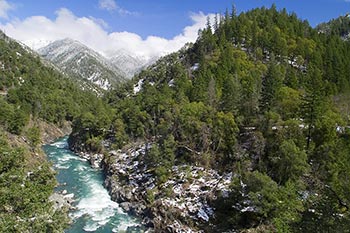Salmon River Restoration Council
The Salmon River flows from the high peaks of the Salmon Mountains, a sub-range of the Klamath Mountains, in far Northern California. It is the second largest tributary to the Klamath River and joins the Klamath at Somes Bar, California, about 106 km (66 miles) upstream from the Pacific Ocean.
The Salmon River and watershed have rich natural and human histories.
The watershed is almost entirely public land. There are no dams, major diversions, urban areas, major industry or agriculture in the watershed and, consequently, the water is of exceptionally high quality. The cool, clean water of the Salmon River is crucial the overall health of the Klamath River fishery.
The Salmon River provides excellent habitat for fish and other aquatic life yet benefits from continued restoration efforts aimed to help the river recover from past land management practices including extensive mining, logging, wild fires, road-building, and grazing as well as ongoing threats such as noxious weeds and high summertime water temperatures. The river is listed as temperature impaired under section 303(d) of the Clean Water Act.
Quick Facts
- Watershed area: 1,945 km² (751 mi²)
- Second largest tributary to the Klamath River
- Average river flow near mouth: 51 m³/s (1,792 ft³/s)
- Highest point: Caesar Cap Peak at 2,720 m (8,920 ft) elevation
- Lowest point: confluence with Klamath River at 137 m (450 ft) elevation
- Entirely within Siskiyou County, California
- Entirely within Klamath National Forest
- Public lands: 98.7% of watershed
- Designated Wilderness Area: 45% of watershed (Marble Mtn, Russian, & Trinity Alps)
- Designated Wild & Scenic Rivers: Salmon, NF Salmon, SF Salmon, Wooley Creek
- Eligible Wild & Scenic Rivers: Russian Creek, EF SF Salmon, upper SF Salmon, upper NF Salmon, upper Wooley Creek
- Estimated population: 150 people
- Incorporated towns and cities: None
- Largest local employer: Salmon River Restoration Council
- Karuk, Shasta, & Konomihu Tribes ancestral territory
- Referred to as the "Cal Salmon" by many whitewater paddlers, but don't call it that when talking to a local.
Learn more about the natural history, human history, recreation opportunities of the Salmon River watershed.
Clean, Cool Water for the Klamath River System
At this moment, the Salmon River is providing gallons of clean, cool water to the Klamath River every minute. This immediately increases the Klamath's flow by % and represents about % of the Klamath's flow into the Pacific Ocean.
More information is on our River Flows, Weather, & Wildfires page.


Salmon River Restoration Council
PO Box 1089 | Sawyers Bar, CA | 96027
Salmon River (California)
530-462-4665
![]()
